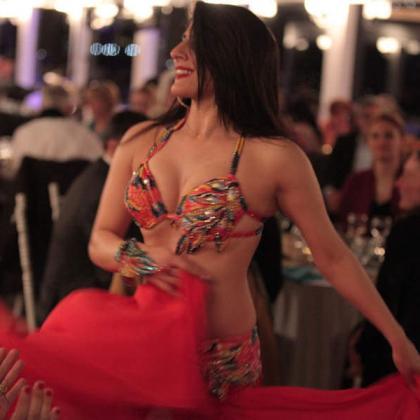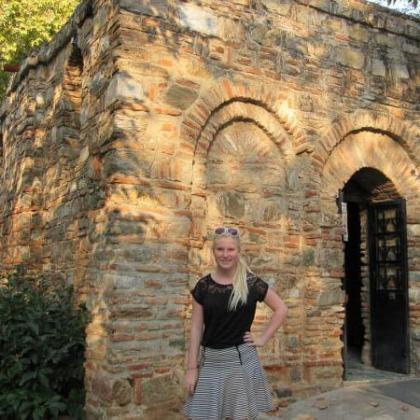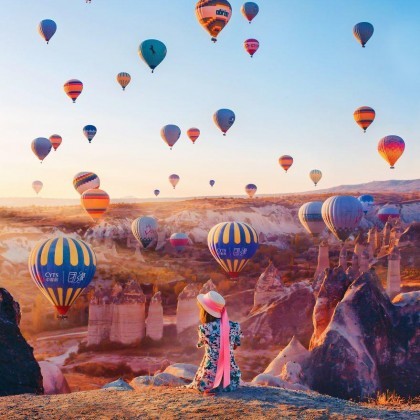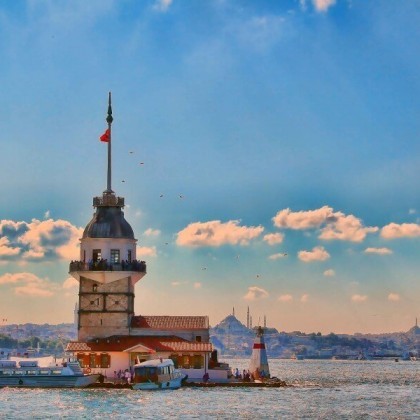Konya
Come, come again and again! Come be you unbeliever, idolator or fire worshipper.
Whoever you are and whatever your condition come! Our hearth is not the threshold of despair. Even If you have fallen a hundred times, come!
—Celeddin-i-Rumi
Konya (pop. 675,000) brims with the lingering flourishes of the Selçuk dynasty, evoking a world of whirling mystics and hushed prayers in sacred candlelit mosques. The city has long played host to spiritual visionaries. In Roman times, when it was called Iconium, a visit by St. Paul initiated the city’s gradual transformation into a Byzantine Orthodox patriarchate. After the Selçuks of Rum invaded and made it their capital in the 11th century, Konya’s churches were replaced with the greatest mosques of the era. In 1228, the great Persian poet Celeddin-i-Rumi, known to many Turks simply as Mevlâna (“our master”), moved to Konya with his family from their home in Afghanistan. Rumi’s poetry and life inspired the now- famous Sufi order known for its Whirling Dervishes. Today, Muslims often stop in Konya to visit Mevlâna’s tomb before embarking on the hajj to Mecca.
Despite a large student population, Konya remains one of Turkey’s most religiously conservative cities. Konya University, with 45,000 students, has had a huge effect on the city’s tolerance, although staunch conservatism remains. Modest, respectful dress may save you uninvited attention; some women travelers choose to wear long skirts and traditional headscarves. Shorts are not recommended for men or women. More information concerning women in public is below.
Istanbul New Year’s Eve Party Cruise on the Bosphorus
IstanbulWith this new year's eve party program in Istanbul, you will have an amazing new year party on the Bosphorus. Book it now and don't miss the special price!
View Tour3 Days Ephesus, Pergamon and Pamukkale Tour Package
Ephesus, Pamukkale, PergamonIf you want to make an amazing trip to the Ephesus, Pergamon, and Pamukkale, you should read our tour itinerary.
View TourIstanbul and Cappadocia Tour – 7 Days
Istanbul, Cappadocia, TurkeyIf you want to make a trip to Istanbul and Cappadocia both, we strongly suggest you join this amazing package tour. This tour covers all the accommodations, transportations, lunches...
View TourBest of Turkey Package Tour – 8 Days
Istanbul, Cappadocia, Ephesus, PamukkaleAre you looking for a good traveling package in Turkey? With our 8-days Turkey tour, you will make a trip to every important sight in Turkey. Enquire now for...
View TourTRANSPORTATION
- Flights: Konya’s airport is about 20km out of town. Buses link the PIT and the airport every hr. ($3). The THY office (351 20 32) is on Alaaddin Bui., off Alaaddin Cad., and offers a service ($3) from the office to the airport. Turkish Airlines flies to İstanbul (1hr.; daily 6:25am; $65, students $50).
- Trains: Konya’s modest railway station is 2km from the town center on Ferit Paşa Cad. To İstanbul (13hr.; daily 5:45, 9pm; $10). To get to town from the gar, take a city bus (5min., every 30min., $.60), or catch a dolmuş on Ferit Paşa Cad. (frequent, $.40).
- Buses: The otogar is on A. Hilmi Nalcacı Cad. Özkaymak (265 01 60) and Aksel (265 01 42) service Konya.
|
DESTINATION |
DURATION |
FREQUENCY/TIME |
PRICE |
|
Adana |
5 hr. |
9 per day 6:30am-1:30am |
$10 |
|
Afyon |
3 hr. |
6:30, 10am, 3:30, 11pm |
$8 |
|
Alanya |
5 hr. |
6 per day lam-3:30am |
$10 |
|
Ankara |
4hr. |
4am-1am |
$8 |
|
Antalya |
6 hr. |
8, 11am, 2, 6pm, midnight |
$10 |
|
Aydın |
8 hr. |
9pm |
$15 |
|
Bodrum |
12 hr. |
7:30pm |
$15.70 |
|
Bursa |
7 hr. |
9am, 2, 9pm, midnight |
$15 |
|
Denizli |
6 hr. |
9pm |
$13 |
|
Erzincan |
10 hr. |
8pm |
$17 |
|
Erzurum |
12 hr. |
5:30pm |
$22 |
|
Göreme |
3 hr. |
8, 9,11am, 2pm |
$9 |
|
İstanbul |
12 hr. |
9 per day 10am-midnight |
$18 |
|
İzmir |
8 hr. |
7 per day 6:30am-12:30am |
$12 |
|
Kayseri |
5 hr. |
9:30am, 6pm |
$10 |
|
Malatya |
10 hr. |
10pm, 11:30pm |
$18 |
|
Marmaris |
13 hr. |
10:30pm |
$18 |
|
Mersin |
4 hr, |
5:30am-1:30am |
$10 |
|
Milas |
9 hr. |
7:30pm |
$16 |
|
Muğla |
10 hr. |
7:30pm |
$16 |
- Local Transportation: A Light Railway connects Konya University, the otogar on A. Hilmi Nalcaci Cad., and Alaaddin Tepesi. Tickets can be purchased at any of the many stops along the route ($.30, Konya University students $.20).
- Taxi: Stations are located throughout the city, mostly near the main tourist sites like Mev- lâna Müzesi and Alaaddin Tepesi.
ORIENTATION AND PRACTICAL INFORMATION
Konya’s main street runs between the turquoise-domed Mevlâna tomb and the circular Alaaddin Bui., which embraces Alaaddin Tepesi (Alaaddin Hill), actually a prehistoric burial mound. The section of road closest to the Mevlâna Miizesi and tomb is called Mevlâna Cad.; the other half is Alaaddin Cad. Most of Konya’s sights, hotels, and restaurants are in this area.
- Tourist Office: 65 Mevlâna Cad. Across from the Mevlâna Müzesi. Look for a green sign. Little English spoken. Take advantage of their free but unhelpful city maps, but take their accommodation and carpet shop advice with a grain of salt. Open M-F 8am-noon and 1:30-5:30pm.
- Banks: On either side of Alaaddin Cad. Most have ATMs.
- Luggage storage: At the otogar. $3 per bag. Open 6am-10pm.
- Hamam: (353 00 93). For the real deal, head to the hamam across from the PIT, behind Şerafettin Cad. Men’s entrance across from the mosque; women’s entrance around the corner. Open for men daily 5am-midnight, for women daily 9am-8pm. $5 for the works. The popular Şifa Sultan Hamam (e-351 80 34) is down Sırçalı Medrese Cad. Men’s entrance across from Şahibi Ata Camii, women’s entrance around the corner. Open for women 8am-7pm, for men 9am-midnight. $3 for the works.
- Police: (322 28 16). On Ferit Paşa Cad., known to locals as Form Cad. Open 24hr.
- Hospital: State-run Nunune Hastanesi (235 45 00), Is on Flastane Cad. The receptionists don’t speak English, but most doctors do. TIP Medical Faculty (323 26 00) is on the outskirts of town.
- Internet Access: Express Internet City (a 350 78 66), on Alaaddin Bui., near the bus offices. $.80 per hr. Open daily 9am-l 1pm. Millennium Internet Cafe, the first right on Meram Yolu, has 40 quick connections at $.50 per hr. Open daily 9am-mldnight.
- PTT: (s-352 02 55), on Alaaddin Cad., across from Şerafettin Camii. Postal services open daily 8:30am-5pm. The branch on Vatan Cad. handles most package services.
Postal Code: 42000.
ACCOMMODATIONS
Most of the hotels and pensions are tucked away in alleys off Mevlâna Cad. Room rates are high, but prices tend to be negotiable. Hot water is often only available upon request—be suspicious if it’s guaranteed. Women traveling alone should avoid the bazaar and spend extra money to stay in hotels along the main streets.
Mavi Köşk Oteli, Mevlâna Cad., 13 Bostan Çelebi Sok. (s-350 19 04), one block from Mevlâna Müzesi. A standard backpacker haunt, appropriate for groups of 2 or more. 9 rooms with TV, some with bath. Singles $10; doubles $10-12; triples $15.
Yasin Otel (351 16 24), in the bazaar, on the second right from Aziziye Cad. Spacious rooms with baths, TVs, and hot water. Breakfast $2. Singles $7; doubles $12.
Otel Çeşme, Istanbul Cad., 35 Akifaşa Sok. (351 24 26). Follow Mevlâna Cad. toward Alaaddin Tepesi, turn right on İstanbul Cad., and take the first left. 25 small, spotless rooms with TV and bath. Ask for a room in the back. No English spoken. Singles $12; doubles $15; triples $20; quads $30.
Hotel Bey (352 01 73). Take the first right off Istanbul Cad. when headed away from the bazaar. Clean and comfortable rooms, sparkling with less-is-more charm. A good option for women travelers. Breakfast included. Singles $14; doubles $20.
Hotel Dergâh, 19 Mevlâna Cad. (351 11 97 or 351 76 61; fax 351 01 16), next to the tourist office. Convenient location. This 2-star hotel features 86 big, somewhat dark rooms with phones and bath. Breakfast included. Rooms $16-30.
FOOD AND ENTERTAINMENT
Konya’s specialty is fırın kebap, a chunk of oven-roasted mutton served unceremoniously on a pide, sometimes under the alias tandır kebap just add yogurt, and you could mistake it for İskender kebap. Konya is also renowned for its Turkish pizza, here called etliekmek. There are plenty of cheap eats on Konya’s backstreets, but, the atmosphere might be uncomfortable for women traveling alone. Women should choose restaurants that advertise a family (aile) section. Unsurprisingly, alcohol is hard to find in this conservative burg.
Köşk Konya Mutfağı (352 85 37). With the Mevlâna Müzesi on your left, take a right at the end of Mevlâna Cad., and then take your first right. A bare brick wall and plastic Coke sign conceal a 150-year-old house that serves terrific food. Specialities include gebzeli çöp kebap (kebap with eggplant; $2.50), çöp şiş ($2.50), and etli yaprak sarması (meat-stuffed grape leaves with yogurt; $1.50).
Şifa Lokantası, 56 Mevlâna Cad. (352 05 19), on the corner of Aziziye Cad. As wholesome as it gets, Şifa will fill you up for $2-3. Vegetarian options. Caters to tourists and families. Open daily 7am-10:30pm.
Dilayla Restaurant, 68 Mevlâna Cad. (354 27 40). Past Şifa Lokantası, and smaller and less touristy. Free deliveries, including to Hotel Dergah across the way. Has a comfortable aile (family) section. Meals $3-4. Open daily 7am-llpm.
Hotel Şahin, 39 Mevlâna Cad. (251 33 50). One of the few bars In Konya. Beer $1.60; vodka $4 per shot; whiskey $6 per shot. This dimly lit establishment is closed to single women. Open until 2am.
Ankara Pastanesi. Turn left from Alaaddin Cad. onto Alaaddin Bul.; the cafe is on the left. Try the delicious milk puddings. Frothy instant coffee provides a quick caffeine fix.
SIGHTS
Konya’s museum is dedicated to recalling its Selçuk glory days. The city’s architectural riches showcase such classic Selçuk designs as carved loops and swirls, luminous tiles, octagonal or decagonal floor plans, and flowing quotations from the Qur’an. To read more about Selçuk Architecture. These sights have great religious significance; for tips on visiting Muslim holy places, sec Visiting Mosques.
MEVLÂNA MUSEUM
Mausoleum, museum, and monument in one, the Mevlâna Müzesi (a.k.a. the Mevlâna Tekke) is marked by its tower of sea green tiles, erected over a century after Kumi’s death. Inside the well-touristed mausoleum lie the turban-domed sarcophagi of Rumi, his father, his oldest son, and his closest disciples. The original site of the museum was a rose garden planted by the sultan for Riuni’s father. Later, Sufis who joined the Mevlevi order lodged in the chambers here. In 1954 it was restored as the Mevlâna Museum.
Enter through the “Door of the Dervishes,” passing the ticket window. To the immediate right, in front of the kitchen pavilion, is the Wedding Night Pool, named for the day of Rumi’s death, the night of his union with his Creator. Every year on that date the dervishes would gather around the pool and perform whirling rituals. Today, visitors pray here and drink the sacred water. To the left stands a fountain given to the site in 1512 by Sultan Yavuz Selim. The Mevlâna museum and mausoleum is straight ahead, with the entrance to the right. In the first small room, the reading room, dervishes recited and copied the Qur’an. Some verses, written in extraordinary Arabic, Persian, and Turkish calligraphy, hang on the walls.
In the hushed and colorful main hall, approximately sixty tombs hold the bodies of Rumi’s family and friends. Male disciples are buried in the tombs capped with turbans; those without turbans hold female disciples. The color of the turban indicates the status of the person buried in the tomb: green means that the person was a family member and white indicates a friend. Bigger turbans represent, chiefs of the dervishes. The dervishes used the bowl and chain Nişan Taş displayed along the left wall to collect April rainwater, believed to have medicinal properties. To the left of the bowl is a famous line from one of Rumi’s poems written in Arabic, Persian, and Turkish: “Either be as you appear, or appear as you are.” The two largest and best-lit tombs at the end of the hall hold Rumi and his son are and often surrounded by chanting pilgrims on the hajj. The black silk cloth with gold embroidery that covers the sarcophagi was given by Sultan Abdülhamid II in 1894. Rumi’s father is buried in the wooden sarcophagus next to these two tombs.
The next room was constructed in the 16th century’ for the dervishes’ whirling rituals. Musicians performed on the raised platform, and men watched on the lower platform to the right. Women watched from upstairs. Now the space houses instruments and prayer rugs used by Rumi, crystal chandeliers with ornate marble lattices, Rumi’s clothing, and the serpuş (hat) of Şems, Rumi’s most beloved mentor.
The next room houses manuscripts from the 12th-19th centuries. Among them are old editions of Rumi’s work, copies of the Qur’an (one of which fits into a tiny silver pillbox), examples of rich Islamic miniatures, and several specimens of calligraphy. Another box holds part of Muhammed’s beard. There are also two strings of prayer beads, used by dervishes for group prayer: assembled on the floor in a circle, the dervishes rotated the large elliptical balls iri turn with their prayers.
In the kitchen pavilion, across the courtyard from the museum, wax models illustrate the dervishes’ daily life. The wax figures show dervishes cooking and eating, all in meditative silence, discussing theological questions, and whirling in a trance. The single figure in the small niche to the left is a Nevniyaz (dervish candidate). Candidates sat in a room in the kitchen and prayed for three days. If the dervishes agreed to let him train, he underwent an initiation known as the “1001 days of suffering,” in which he had to successfully complete 18 kinds of services, ranging from toilet cleaning to food serving. If he found his shoes in his cell when he woke up in the morning, he continued his service; if they were gone, he had to leave quickly and quietly. Fortunately for the model, his shoes are still there.
Across from the main museum complex are rooms displaying dervish dwellings as well as a 35mm. video recounting the museum’s history through the evaluation of Rumi and the Mevlevi order. A mesmerizing finale includes the whirling dervishes in action. The film is available in English upon request.
Every year from December 10-17, Konya celebrates Rumi’s extraordinary life. The festivities include one of the few opportunities to see whirling dervishes perform. The celebration is popular, so reserve rooms in advance. (Museum open M 10am-5:30pm, Tu-Su 9am-6pm. $2, students $1. The building is considered a holy place. The staff will lend those wearing shorts a sarong to wrap around their legs. Shoes must be removed and carried. Women should cover their heads. Head scarves are provided at the door.)
NEAR THE MEVLÂNA MUSEUM
The Selimiye Camii, completed in 1587, stands next door to the Mevlâna Müzesi. Konyans gather to pray here under a beautifully decorated tomb and crystal chandeliers that hang almost within arm’s reach. The design on the mosque’s carpet mimics the one on the dome above.
Aziziye Camii, in the bazaar off İstanbul Cad., was built between 1671 and 1676 at. the behest of Sultan Mehmet IV’s bookkeeper and renovated in 1891. The mosque’s design is a mix of Baroque and Rococo styles. (Mosques open 8am-6pm.)
ŞERAFATTİN CAMİİ AND MAUSOLEUM OF ŞEMS
Across from the PTT on Mevlâna Cad. stands the impressive Şerafattin Camii, whose Selçuk mosaic tiles and classic Ottoman minaret suggest the periods of its construction (13th century) and restoration (17th century). If you walk out behind the Şerafettin Camii down the small street past a hamam and into a small park on the left, you will come to the Mausoleum and Mescid of Şems of Tabriz. The Selçuk-style mausoleum, supposedly built on the site where Şems’s murdered body was found, contains his wooden catafalque. (Mausoleum open 9am-6pm.)
ALAEDDIN CAMII
The Alaeddin Camii stands atop Alaeddin Tepesi, a hill that may well conceal countless as-yet undiscovered layers of human history stretching back to the Bronze Age. Closer to the surface are a park and some quiet tea gardens, crowned by the 13th-century Alaeddin Camii. One of Konya’s oldest fixtures, it was built when the region was newly conquered, and its Syrian Selçuk architecture shows the influence of non-Islamic cultures. The mosque now has iron beams that span the eyvans (arches) and columns that emerge gracefully from the floor. The visually eloquent mihrab (prayer niche), covered in inscriptions and multicolored tiles, compensates for the lack of external decoration. A courtyard within the mosque houses 2 pavilions, containing the bodies of 6 sultans. Tiny stones are stuck in crevices along the outside wall of the mosque, facing the Selçuk Pavilion. Visitors pick up a stone from the area, make a wish or say a prayer, and then throw the stone at the wall. If it sticks, the prayer will be answered or the wish will come (rue. Downhill from the mosque are the remains of the Alaaddin Palace of Selçuk Sultan Kılıç Arslan II (1156-1192). (Mosque open daily 9:30am-5:30pm.)
KARATAY MEDRESE AND TILE MUSEUM
This 13th-century school for teaching the Qur’an and Shar’ia Law to young Selçuks w’as built by Emir Celâleddin Karatay, a close friend of the Mevlâna and a “voice of reason” to counter Rumi’s spiritual and poetic ecstasy. The medrese has rather logically become a tile museum, since the interior itself is a marvelous example of Selçuk tilework. A tile- covered dome hovers over a square central pool. The now-empty pool, which was open to the sky, reflected the stars at night. Students measured the reflections to learn the distances between stars. The inside of the dome is covered with a pattern of interlinked stars, though age and decay have destroyed the upper tiles. Displays include tiles from Kubadâbâd Palace, near Beyşehir Lake, and ceramic plates from
Konya. (On Alaaddin Bul., across from the Alaaddin Palace. 35119 14. Open daily 9am-noon and l:30-5:30pm. $1.40.)
OTHER MUSEUMS
Konya’s Stone and Woodwork Museum is in the İnce Minare Medrese (Medrese of the Slender Minaret). The highlight is a massive stone portal whose arch is engraved with Arabic script and bas-relief plants. The minaret from which the medrese took its name was struck by lightning in 1901 but has since been rebuilt. Inside are works from the Selçuk, Karamanoğulları, and Ottoman periods, including winged angels and double-headed eagles carved in stone. The woodwork exhibit features carved doors and shutters and yazma stamps. (On Alaaddin Bui., next to McDonald’s. Closed for renovations, the museum should reopen by 2004.)
Konya’s Archaeological Museum contains artifacts from prehistoric times to the Byzantine era. One of the 3rd-century Roman sarcophagi on display illustrates the labors of Hercules. The museum also contains extraordinary finds from nearby Çatalhöytik (see below), including the remains of a year-old infant, buried under the floor of her family’s house. Ancient toiletries include Roman ivory combs and toothpicks. (On the small Şuhibi Ata Cad., about 7 blocks south of Alaaddin Tepesi. Open Tu-Su 9am-noon and l:30-5:30pm. $1.40, children and high school students free.)
Turn left out of the Archaeological Museum gates to get to the Ethnographic Museum, displaying ornate embroidery, clothing, jewelry, metal hats, and hunting equipment that includes a small metal contraption used to make deer noises. (351 89 58. Open Tu-Su 9am-noon and l:30-5:30pm. $1.40, students $.50, children free.)
DAYTRIPS FROM KONYA
ÇATALHÖYÜK
The easiest way to get to Çatalhöyük is to take a dolmuş from Konya’s otogar to Çümra (45min., 6-7 per day 9am-6pm, $. 75), from where a taxi can take you the remaining distance (10min.; $20, tty to bargain).
The neolithic town of Çatalhöyük, dating back to the 8th millennium BC, vies with Jericho for the coveted title of “World’s First City.” Near the town of Çümra, 50km south of Konya, the 9000-year-old town is touted as the most important archaeological site in Turkey. Çatalhöyük was home to between 5000-10,000 people for 1000 years, and was one of the largest and most complex settlements of its time.
Archaeologist James Mellaart discovered the site in 1958. The most sensational objects from Çatalhöyük are the female figurines, particularly one of an ample, naked woman, seated on a throne of leopards, who appears to be giving birth. Archaeologists have found carved female breasts that have vulture beaks within them. Some conclude that the town was a matriarchal society that worshipped the Mother Goddess, but not enough evidence has been found to support the theory.
Çatalhöyük families lived in compact mud-brick houses which were used for cooking, sleeping, and religious worship. When family members died, they were buried under platforms in the house. About every 100 years, residents would fill in the house and build a new one on top of it, eventually forming a mound 20m high.
The enormous site is slowly being excavated by an international team. Archaeologists eagerly await discoveries about and insight into the ancient culture’s art, symbolism, mythology, textiles, use of pottery, metals, and wood, and domesticated plants and animals. Although the most important finds have been whisked to Ankara’s Museum of Anatolian Civilizations (see p. 396), the site offers a uniquely interactive experience. If you visit the site between July and mid-September, you can watch the excavation in progress and talk with the archaeologists and other workers. Usually, however, a guard will show you around. The site includes a museum with finds from the 1993 excavation and a replica of a Çatalhöyük house.
WHIRLING DERVISHES
Legend holds that Celeddin-I-Rumi’s mystical order derived from the great teacher’s encounter with the rhythmic banging of a goldsmith’s hammer. So sensitive was Rumi to the pounding that he began to spin in ecstasy. A passing imam was so engaged that he offered himself to Rumi as a disciple. Since then, the whirling ritual (sema) has been fine-tuned and is laden with distinct symbolism, while still retaining its otherworldly effects.
The spiral form is natural to all living things. Through the sema, the dervish (“door-way” in Arabic) communes with the divine by imitating one of nature’s most innate states. The right palm, upheld to the sky, channels the power of heaven through the dervish’s body and out to the earth through the down-turned left palm. The combination of whirling in the manner of the earth’s rotation and the transition of energy results in a trance-like state, whose effects on the actor’s body have been scientifically documented (they don’t get dizzy. The dervish’s white dress signifies the ego’s burial shroud, capped off with the camel hat as the ego’s tombstone, indicating the inevitable death of man and his passing importance.
OTHER DAYTRIPS
SİLLE
Sille, 8km from Konya, can be visited in one morning. Visitors come to see the Aya Elena Kilisesi, a 4th-century Christian church decorated by more recent frescoes. (Open Tu-Su 9am-4pm. $1.) The two caves facing the church were inhabited at one point. Sille-bound bus #64 leaves the municipal bus stop (on Alaaddin Cad., across from the PTT) every 30min. ($1), stopping in the middle of Sille’s main street, distinguished by the standard-issue Atatürk bust. The PTT is ahead and around the comer (open M-F 8:30am-12:30pm, l:30-5:30pm), and the church lies 50m past the PTT on the main road.
MEKE CRATER LAKE
A unique erosion formed the centerpiece for the panoramas and wildlife that surround this aquatic doughnut in an otherwise entirely flat landscape. Nearby Killstra, a purportedly Roman city turned rock-integrated-city à la Cappadocia, is believed to have been a stop on St. Paul’s ancient world tour. (Buses run to nearby Karapınar (2hr., 8am-7pm) from the otogar. A taxi to Kilistra costs $35.)
“I WAS RAW, then I got cooked, and finally got burnt.” –Rumi Mevlâna Celeddin-i Rumi,
The greatest of all mystical Persian poets, made his home in 13th-century Konya after leaving his native Balkh (now part of Afghanistan) during the Mongo! invasion. Following in his father’s footsteps, Rumi became a highly respected traditional Islamic scholar and was the head of a medrese, a theological school. When Rumi was about 37 years-old, he met Şems of Tabriz, a 60-year-old wandering Sufi master from Iran. Şems purposely shattered Rumi’s dependence on intellect a$ the only means for knowing God and, in doing so, revealed Rumi’s own source of divinity and the power of love. The two men became inseparable and went into week-long periods of sohbet, mystical conversation and merging. Şems mysteriously disappeared in 1248 (he was purportedly murdered by envious members of Meviâna’s entourage). Rumi expressed the wrenching experience and revelations that resulted from this spiritual consummation in spontaneous and ecstatic poetry, music, and dance. Above all, Rumi considered love the greatest guide on the mystical path. His passion-filled poetry of flaming hearts, moonlit gardens, and grievous longing is an account of the meeting, loss, and fervent mystical union of Rumi with Şems, Rumi with God, and Rumi with his true divine self as they all become interchangeable in their spiritual positions of Lover and Beloved.
Rumi’s most famous poems were compiled into Divan-i-Şemseddin-i-Tabriz (1870 pages, 42,000 lines of poetry) and his later work of lyricism and stories, Mathrawi (25,618 couplets). His verses have inspired centuries of readers throughout the Middle East, South Asia, Africa, and the West. After Rumi’s death on December 17, 1273 (called his “Wedding Night” with the divine), his disciples founded the Mevlevi Order, known abroad as the “Whirling Dervishes” because of their meditative ceremonial dance, or sema. For English-speaking readers, Coleman Barks provides an evocative English translation of Rumi’s poetry. Anne-Marie Schimmel’s I am Wind, You are Fire is an excellent introduction to Rumi’s life and teachings.





